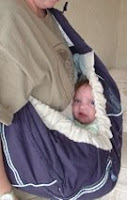Last week I posted about the Serena and Lily sling worn by Jennifer Meyer McGuire being a “bag sling.” Since in the baby carrier community “bag sling” is virtually the same as a four letter word, I wanted to post a little more information about bag slings, to back myself up (since I typically support use of all baby carriers) and to get the word out there.
Bag slings are a broad term for carriers that act more like a bag for baby than a carrier that holds the baby snugly against the wearer’s body. Whereas pouches and ring slings are shallow – or can be made shallow – bag slings have deep pouches with little or no adjustability. They have no way to wear baby in the proper position for their safety and yours. I should note that while the S&L sling is not technically a bag sling since it doesn’t have a flat bottom or elasticized sides. However, it functions much like one in that it has a large, deep pouch with improper support for baby.
Here’s an illustration of a generic bag sling.  This type of bag sling is the most dangerous for your child. But any carrier which does not allow for proper positioning of your child increases the risks.
This type of bag sling is the most dangerous for your child. But any carrier which does not allow for proper positioning of your child increases the risks.
The article below is written by M’lis Stelzer, former RN, now a babywearing educator and mom to 2, about her research into bag slings.
Potential Dangers of Bag Slings
With the majority of fabric carriers it takes only a few minor adjustments to get baby safely and comfortably positioned (see the article “Correct Positioning”) however, it appears that ‘bag slings’ have several significant design flaws that could place an infant at risk of respiratory distress or oxygen deprivation.
First, bag slings are roughly triangle shaped; flat bottom and two sides that slant upwards toward the elastic top. This “triangle” means that the pouch fabric is always angled very close to the sides of baby’s face. If baby rotates even slightly he ends up with his nose within a ¼” of the side, or even pressed against the side of the pouch. Once baby has his head pressed against the side of the carrier and/or against the parent’s body there is a risk of him becoming oxygen deprived or even suffocating.
Second, it is difficult for the parent to closely monitor their infant unless the top of the sling is pulled open. Bag slings are generally deep, plus they sag when baby is placed in it, further increasing the depth of the carrier. The gathered top, and the fact that the sling hangs so low, obstructs the parent’s view of baby. If a newborn were to have difficulty breathing, and/or rotate until his nose and mouth was pressed against the side of the carrier, the parent may not be aware of the baby’s respiratory distress for some time. Compounding this problem is the difficulty of feeling the baby’s distress through the thick fabric of the sling.
Third, although there are bag slings designed with large mesh panels placed near the infant’s head, others are not. There is a possibility that, with only a very small opening at the top of a non-mesh sling, an infant may not receive an adequate amount of fresh air. There is the concern that carbon dioxide levels could rise the longer the infant remains in the sling.



For more information on the dangers of re-breathing see this article:
“About Carbon Dioxide Poisoning and SIDS”
Fourth, the design of a bag sling causes baby to curl chin to chest, larger babies more so because their heads are positioned further up in the carrier. This position kinks baby’s airway causing the baby to work harder to breathe.

Additional chin to chest photos on these manufacturer websites:
For more information on the importance of maintaining an infant’s head and neck in an aligned position see the articles:
“Baby car seat ‘cot death’ concerns”
“Simple Car Seat Insert to Prevent Upper Airway Narrowing”
PEDIATRICS Vol. 112 No. 4 October 2003, pp. 907-913
Compare bag slings with a shallow fabric pouch (below left) or adjustable open-tailed sling (below right) or mei tai or wrap. In these types of carriers an infant is easily monitored. Also, a newborn’s head is effectively sandwiched between the sides of these carriers, preventing the infant from easily rotating his head into the sides of the carrier.


For more information, including the specific results of M’lis’s research, see her blog post here.
For the record, M’lis says she has made repeated attempts to contact manufacturers of these carriers, as well as the CPSC, with few results. You can read about her efforts here (must be a member of thebabywearer.com -well worth the few minutes it takes to register for free).





